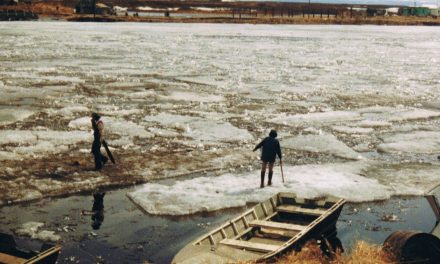All at once, viewed from the coffee shop window, a flock of fifty or so pigeons lifted off and rose into the air, swooping and wheeling in ragtag unison–once…twice…three times–only to gradually reassemble on exactly the same overhead power lines and as far as I can tell, in exactly the same positions. Guess it was time for a stretch and a quick look around. And then they were gone, altogether someplace else.
Given half a chance, life is exuberant, spontaneous, surprising in its resilience.
The scene called to mind my first snowshoe excursion from an Eskimo village after the river had frozen and the tundra was blanketed under several feet of snow–creating a silent, and brilliantly white expanse, reaching as far as the mountain range–easily 20 to 30 miles off–that served as a point of reference in an otherwise flat, near-sea-level landscape.
Flat except for numerous depressions and ponds I would have called buffalo wallows anywhere else, dropping as much as five or six feet from “level,” and surrounded by bushes with only the buds of next spring’s growth on their branches. Earlier, before freeze-up, I had gotten completely disoriented hiking after sunset, when I had emerged from a “wallow,” facing the wrong direction and not able to recognize anything familiar. Only after descending back into the “wallow” and coming up on the other side was I able to make out the blinking lights of the village along the river about half a mile distant.
For a city boy, the utter quiet and remote surroundings were initially unsettling, with every turn in the river further complicating my sense of direction, and opening into yet a broader vista of snow and dormant, skeletal bushes. The crunch of my snowshoes was the only sound; no other signs of life…until I mounted the river bank and startled a flock of 50 ptarmigan, not twenty feet from where I had left the river. The flock exploded into the air and quickly disappeared into another depression fifty yards away.
Given half a chance, life is exuberant, spontaneous, surprising in its resilience.
Given half a chance, communities are exuberant, spontaneous, surprising in their resilience.
From the cross-generational games and competitions that filled the long, year-end holiday nights of that arctic village to a pre-harvest street dance in a rural Oklahoma town; from the all-hands on deck preparation of winter kimchi in Seoul to the bartering rituals for virtually everything in a neighborhood market in Medan, there is an insistent, irrepressible quality that turns a hodgepodge gathering into a community.
This quality has its own logic, but not the rationality of a vision or mission statement; its own sense of timeliness and rhythm, not captured on a project schedule; perhaps more often found where least expected, for it springs up beyond the reach and sometimes in apparent defiance of wealth, power and influence.
Pattern discovery is a treasure hunt for the conditions that nurture and release this quality; all at once and complete, over and over again, yet never the same.


